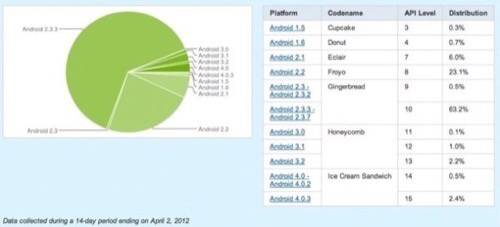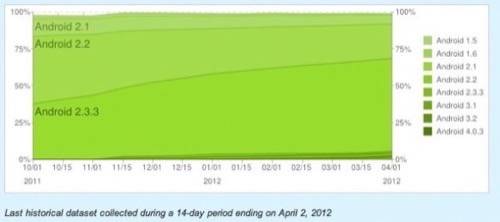The Android software ecosystem has finally consolidated around one primary version. The problem? It is last year’s version. As of April 2, 63.7% of Android devices are running version 2.3, giving Gingerbread a comparable penetration to how many users have downloaded and are using iOS 5. While the ecosystem has consolidated around Gingerbread and held steady, Android 4.0 Ice Cream Sandwich nearly doubled its penetration, rising from 1.6% to 2.9% in the last month.

It will take a long time to unseat Gingerbread as the dominant version of Android. Frozen Yogurt held the top spot for most of 2011, and it was not until November, 11 months after version 2.3 was released, that Gingerbread finally overtook Froyo. Unlike Apple, which can hard-push software upgrades easily through iTunes, Google’s Android releases are more like the “soft opening” of a restaurant. It is slow going, but it looks like Ice Cream Sandwich is gaining momentum.

Gingerbread Holds Court
Much of the Android ecosystem is hesitant to move past Gingerbread. It took about a year, but most apps are fully functional with Gingerbread on a variety of screen sizes and chipsets. If there were no such thing as Honeycomb (which holds 3.3% of the market) or ICS, Android developers would be completely happy publishing apps for version 2.3 on 4-inch to 4.3-inch screens. It would make life so much simpler.
But it would stunt the growth of the platform. Google is looking ahead with Android, and it has made a concerted effort to consolidate the design cycle with ICS, both from a developer and a manufacturer perspective. Developers that embrace ICS have a variety of ways to easily deploy their apps to a variety of screen sizes and have backwards compatibility to Gingerbread and Froyo.

While Android 4.0 may not be on many devices as of yet, it is still important for developers to create apps for the newest version of Android first and then work backwards from there. The rate of updates makes it so that developers that deploy for ICS are actually ahead of the curve. Yet, with Gingerbread holding steady near 63% percent of the market, publishers should make sure that their apps work best across version 2.3 and the most frequent screen sizes.
On the Horizon
It is almost astonishing that ICS was able to nearly double its penetration in the last month. There are not many devices on sale through U.S. carriers that actually come with Android 4.0 pre-installed. The Samsung Galaxy Nexus, the ICS flagship device, has been available on Verizon since late last year but Big Red does not have any other substantial Android devices running ICS. AT&T still does not have any ICS device on its shelves, and the first one will likely be the HTC One series expected to drop in May. Samsung’s Galaxy Skyrocket HD will launch with ICS on AT&T, but the release date for the device has not yet been announced.

So, how did ICS grow to almost 3% in March? Updates are the only reasonable answer, but the OEMs and carriers have not made a concerted effort to push ICS to the mass of Android devices. In early March, Verizon announced that eight smartphones from HTC and Motorola (and all three of Motorola’s tablets) will be upgraded to Android 4.0. Similar updates for newer Android devices will come from Sprint, T-Mobile and AT&T, and will likely drop within the next three months.

The odd man out in the update cycle is Samsung. The South Korean manufacturer has an abnormal amount of power when it comes to Android updates because of its dominant marketshare. Historically, Samsung has dragged its feet when pushing Android updates, preferring instead to announce a new line of devices for the latest flavors instead of pushing upgrades to its many devices already in the ecosystem. It makes great business sense but infuriates users. Samsung also likes to push updates through its KIES system, a painful process for anyone who has ever gone through it. Samsung has worked with the carriers to send over-the-air updates to certain phones, and that is the preferred method of most consumers.
The onus of updating the software of existing phones to newer versions of Android is on the manufacturer. They have to make sure their skins – the software they layer on top of Android to differentiate it from other Android devices – is compatible with the new version. Once the software is ready, the OEMs need to work through the carriers to ship the update. This is often when the carriers drag their feet. Pushing that amount of data over their networks, more or less for free (with some help from the OEMs) is not an intriguing policy for them. The carriers think like the OEMs: The more devices running the newest version that they can sell (as opposed to update) is better for everybody.
Except for consumers, of course.
That being said, look for ICS to double its penetration again in April – and maybe even triple in May – as new devices hit the market. Between new device sales and OTA upgrades, it takes a while for the update cycle to catch up with itself, but once it gains momentum, penetration will accelerate.









